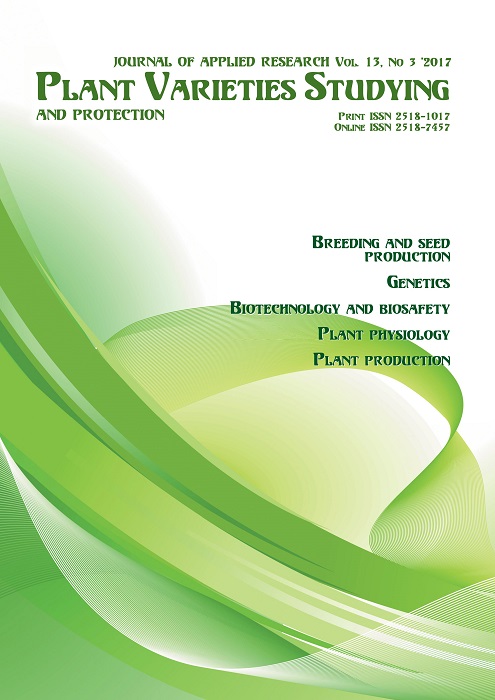Prospects of domestic viticulture transition to ecological (adaptive) management
DOI:
https://doi.org/10.21498/2518-1017.13.3.2017.110712Keywords:
grapes, adaptive viticulture, variety, seedling, resistance levelAbstract
Purpose. To determine the possibility of the domestic viticulture transition to the ecological (adaptive) management system, based on the use of highly adaptive varieties.
Methods. Procedures are conventional in viticulture. All stages of agrobiological research were carried out according to the M. A. Lazarevskiy technique. The resistance of genetic resources to fungal diseases was assessed using the 9-point scale on the natural infectious background with maximum damage. Organoleptic evaluation of wine and fresh grapes was performed using 8-point and a 10-point scales respectively.
Results. The main agrobiological traits (resistance to diseases, productivity and yield quality) of 22 perspective grape varieties and forms were studied. The level of resistance to fungal diseases was determined as one of the main criteria of the variety suitability for ecological (adaptive) viticulture. During five years, the average resistance level of this group of table and wine varieties was not lower than the relative one (6.5–7 points), and in ‘Zagrei’ variety – up to 7,5 points. The level of quality characteristics of products of new grape varieties and forms was determined (wine evaluation, marketability and assessment of fresh table grapes). Samples with a combination of high wine and grape quality characteristics and high productivity were selected. To replenish the gene pool of grapes by adaptive varieties, such perspective hybrid combinations as ‘Opalovyi’ ´ ‘Burmunk, ‘Avgustin’ ´ ‘Oryhinal and ‘Ohoniok tairovskyi’ ´ ‘Kardyshakh’ were studied. The level of group resistance to fungal diseases was identified and the perspective genotypes were preliminarily selected.
Conclusions. The level of display of a number of economic characters in the group of perspective table and wine grape varieties and forms was determined. Highly adaptive and highly productive varieties and forms suitable for the use in the adaptive viticulture were defined. Prospective hybrid combinations were considered, from which highly adaptive varieties will be selected as suitable for the ecological system of viticulture.
Downloads
References
Grigoruk, V. V., & Klimov, E. V. (2016). Razvitie organicheskogo sel’skogo khozyaystva v mire i Kazakhstane [Development of organic agriculture in the world and Kazakhstan]. Kh. Mumindzhanov (Ed.). Ankara: N.p. [in Russian]
Lazarevskiy, M. A. (1963). Izuchenie sortov vinograda [The study of grape varieties]. Rostov-on-Don: Izd-vo Rostovskogo un-ta. [in Russian]
Bankovska, M. H. (2007). Evaluation of grape genotypes resistance to fungal diseases. Vynohradarstvo i vynorobstvo [Viticulture and Vine Production], 45(1), 20–25. [in Ukrainian]
Valuyko, G. G., & Scholz-Kulikov, E. P. (2005). Teoriya i praktika degustatsii vin [Theory and practice of wine tasting]. (2nd ed.). Simferopol: Tavrida. [in Russian]
Prostoserdov, N. N. (1946). Technological characteristics of grapes and products of its processing. In Ampelografiya SSSR [Ampelography of theUSSR] (Vol. 1, pp. 401–462).Moscow: Pishchepromizdat. [in Russian]
Gerus, L. V., Kovaleva, I. A. Saliy, E. V., Fedorenko, M. G., Mulyukina, N. A., Karastan, O. M., & Papina, E. S. (2015). Results of stepped breeding for genetically determined high-level manifestation of economic traits in grape varieties bred by NSC “Tairov Institute of Viticulture and Wine-Making”. Vynohradarstvo i vynorobstvo [Viticulture and Vine Production], 52, 54–60. [in Russian]
Kovaliova, I. A., Herus, L. V., Salii, O. V., Fedorenko, M. H., & Bankovska, M. H. (2014). Practical results of “Resistance and Quality” breeding program. Vynohradarstvo i vynorobstvo [Viticulture and Vine Production], 51, 61–65. [in Ukrainian]
Vlasov, V. V., Mulyukina, N. A., Dzhaburiya, L. V., Kovaleva, I. A., Tulaeva, M. I., Gerus, L. V., … Karastan, O. M. (2014). Ampelograficheskiy atlas sortov i form vinograda selektsii Natsional’nogo nauchnogo tsentra “Institut vinogradarstva i vinodeliya im. V. E. Tairova” [Ampelographic Atlas of grape varieties and forms bred by NSC “Tairov Institute of Viticulture and Wine-Making”]. Kiev: Ahrarna nauka. [in Russian]
Downloads
Published
How to Cite
Issue
Section
License
Copyright (c) 2017 Ukrainian Institute for Plant Variety Examination

This work is licensed under a Creative Commons Attribution-ShareAlike 4.0 International License.
Starting in 2022, the copyright to the publication remains with the authors
Our journal abides by the CREATIVE COMMONS copyright rights and permissions for open access journals.
Authors, who are published in this journal, agree to the following conditions:
- The authors reserve the right to authorship of the work and pass the first publication right of this work to the journal under the terms of a Creative Commons Attribution License, which allows others to freely distribute the published research with the obligatory reference to the authors of the original work and the first publication of the work in this journal.
- The authors have the right to conclude separate supplement agreements that relate to non-exclusive work distribution in the form in which it has been published by the journal (for example, to upload the work to the online storage of the journal or publish it as part of a monograph), provided that the reference to the first publication of the work in this journal is included.

























 Ukrainian Institute for Plant Varieties Examination
Ukrainian Institute for Plant Varieties Examination  Селекційно-генетичний інститут
Селекційно-генетичний інститут Institute of Plant Physiology and Genetics of the National Academy of Sciences of Ukraine
Institute of Plant Physiology and Genetics of the National Academy of Sciences of Ukraine
 The National Academy of Agrarian Sciences of Ukraine
The National Academy of Agrarian Sciences of Ukraine